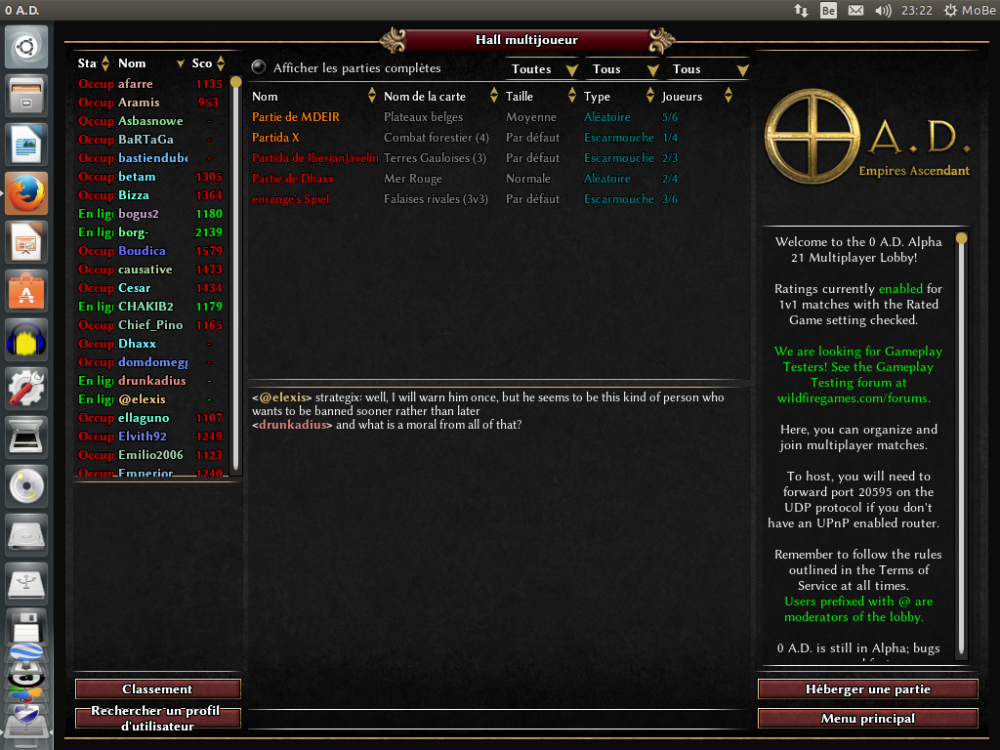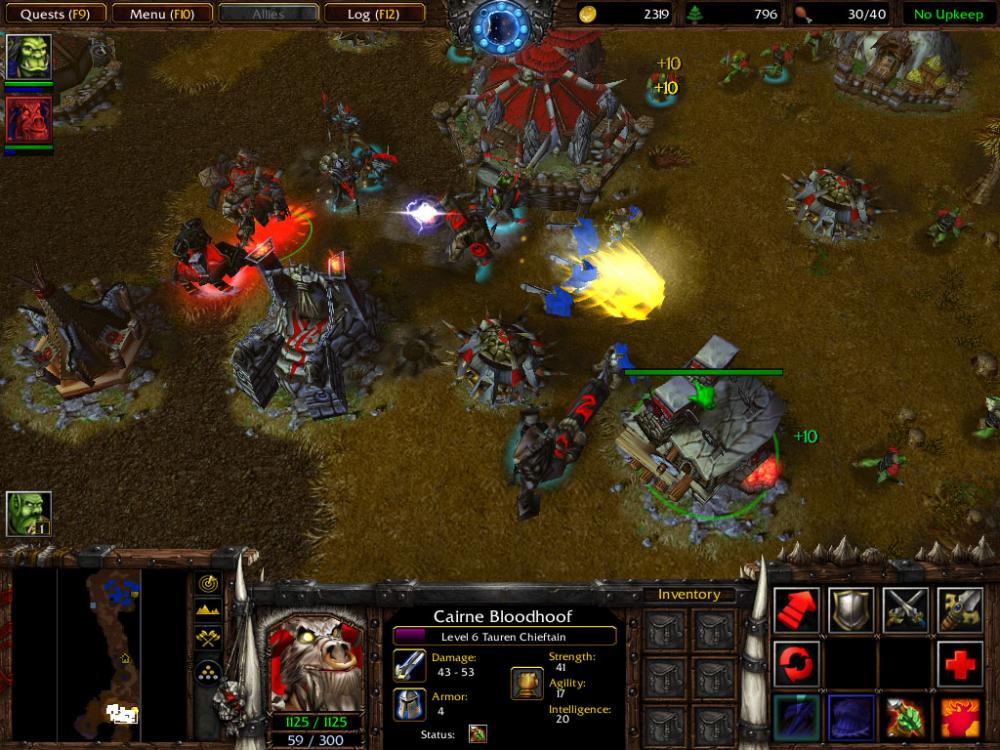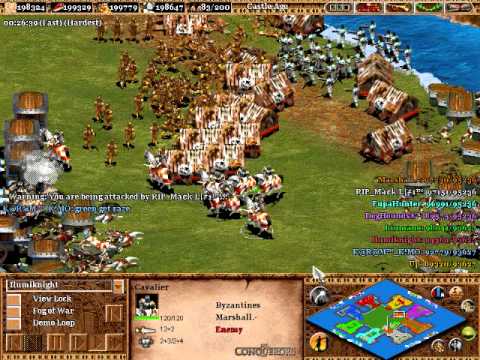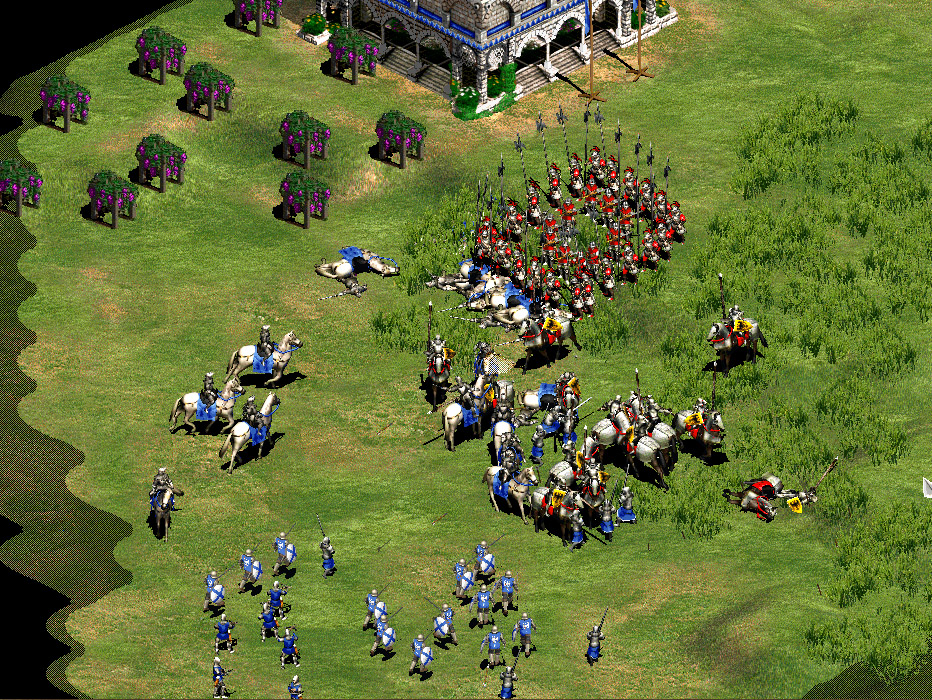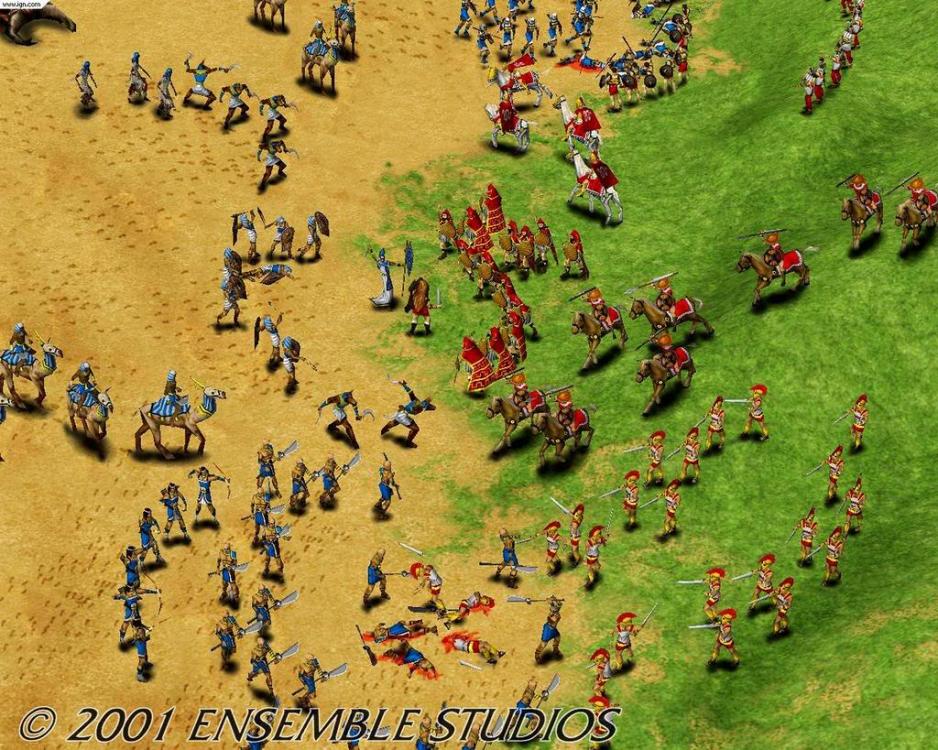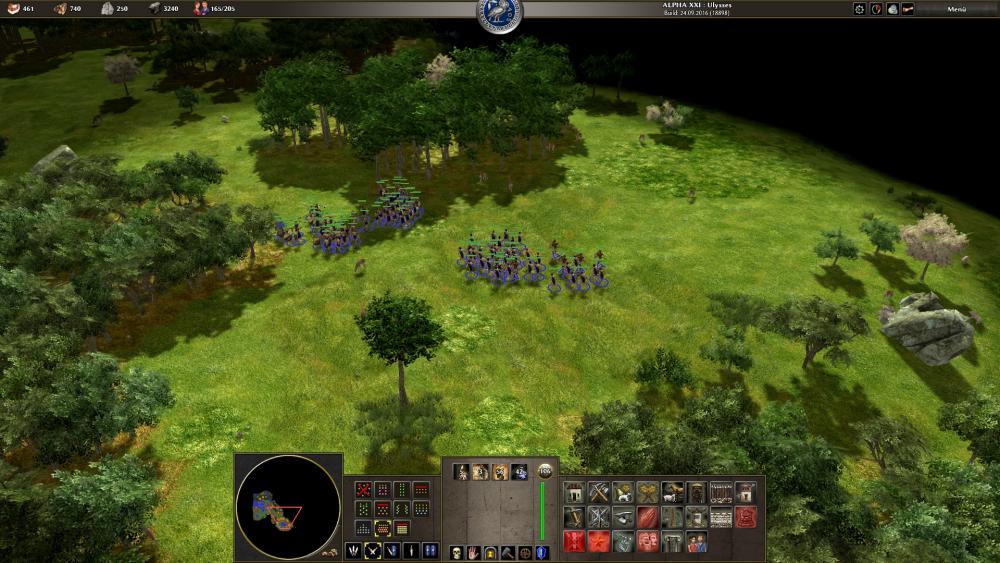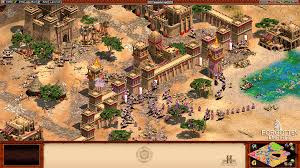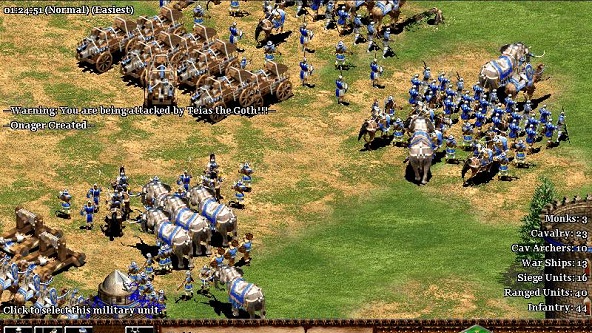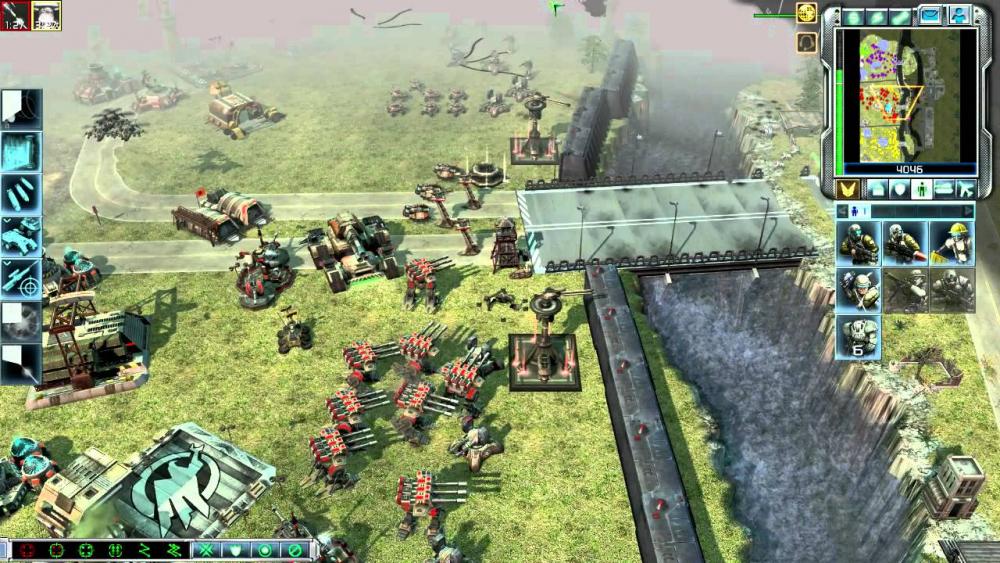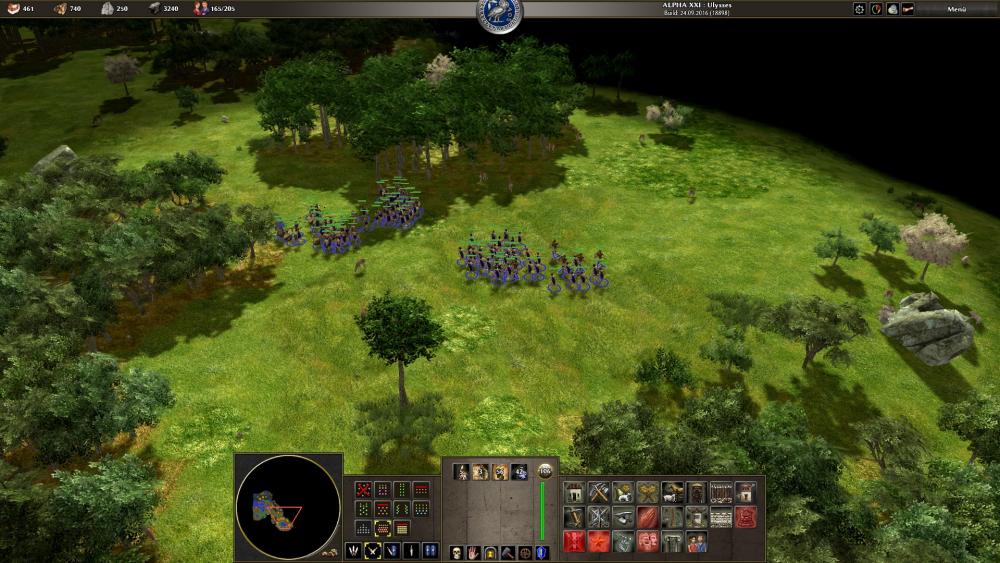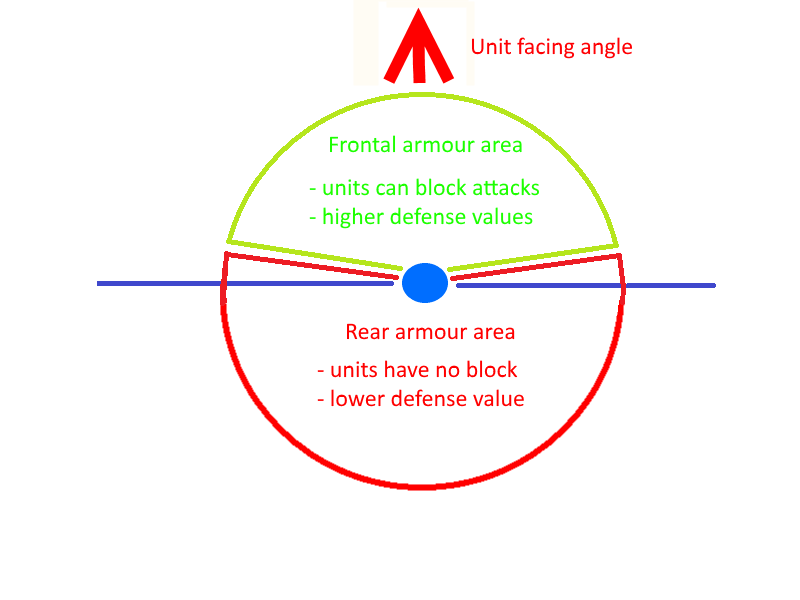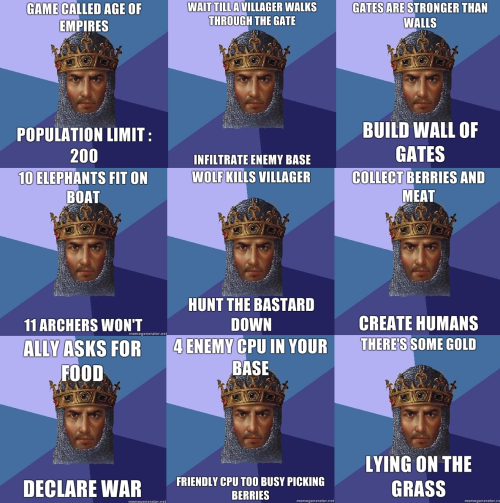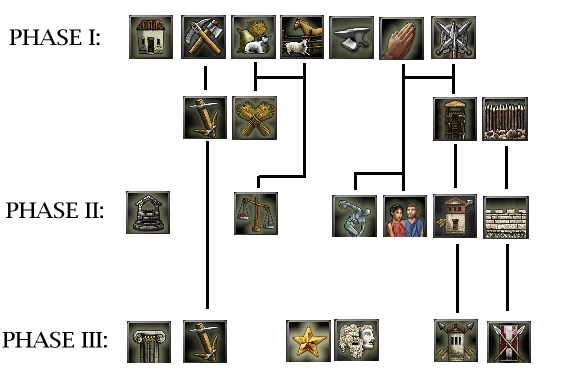Leaderboard
Popular Content
Showing content with the highest reputation on 2017-04-13 in Posts
-
That's entirely dependent on what type of game you are playing/making. I do agree that it's most likely not a good idea for an AoE-like RTS though.3 points
-
@DarcReaver: please mind your tone a little bit, will you? @Lion.Kanzen: if the only change would be to remove the CS concept than it would indeed be even more a AoK clone. However, combined with the other changes mentioned in this thread I think it plays quite differently2 points
-
Hahahaha, always answer the same. is because the realism of the epoch. Only needs some extra stuff and you can convert your peasants in soldiers. Mostly of people that are new , are confused the first time. But with the time, the concept work from early, and in late phase you can mix soldiers with champions. Few soldiers are working. you can't expect all soldiers were medieval or modern full service professional with a commander in the battalion marching to the war. Confess you want a classic game with few personal preferences. for example if they removed SC this game becomes more to be a AOK clone. We can have a mode where soldiers only fights. why not? You still angry? Why don't search a conciliation by both sides?2 points
-
Something that Danny and my ideas share is tying technological progress to physical structures on the map that can be destroyed and thus the technological progress lost. This seems like an avenue worth exploring whether pro-phase or anti-phase.2 points
-
This discussion highlights everything that is bad about phases. Look at the posts endorsing phases, they are all about ways to restrict the player, and arbitrary ways to categorize things into phases. I understand that this is a game and things have to be simplified, and I appreciate the efforts of people to try and improve upon existing ideas (this is in fact more important than new ideas!), but I really think phases/epoch/ages have always been a dead duck in RTS games. A city/civilisation is something that evolves gradually, it does not jump from one age to the next, there is no reason why we cannot have this authentic feeling, there is no real reason to limit the game to distinct phases other than to emulate games that came before. I edited this part out because I went on a rant about how phases make no sense and seem to be completely detached from the game world, but I have deleted that and instead I will try to provide some alternative ideas. Knowledge as a Resource I want technology to be something tangible in the world, not a flowchart disconnected from the rest of the game. I will start by describing a basic settlement and how knowledge is accrued and used by primitive cultures. Each working citizen will accrue a trickle of knowledge while they work (this simulates the natural tendency to innovate and find more efficient ways to complete tasks). For every working citizen, the science score of the civilisation is increased by a small amount; the science score affects the rate at which knowledge is acquired over time. Advanced buildings and units require knowledge to build, however, knowledge is not spent like other resources, but also unlike other resources it must be maintained. The population itself is the basic and most vital store of knowledge, if your population collapses then your technology will disappear along with it! Libraries (as separate buildings or contained within other buildings, e.g. Universities) greatly bolster the civilisation's knowledge base. Buildings such as the Temple, Library, University and Observatory* are places that provide huge boosts to the science score and thus the rate of knowledge acquisition. So knowledge is not a static resource, it is not something that can be simply piled up but can change greatly depending on these factors of population size, libraries and science score. (For the more mathematically-minded amongst us I have attached an image of an equation that produces the desired relationship.) What this means in terms of gameplay is that knowledge (and thus technology) are bound to tangible objects and people that must be protected. * The effectiveness of the observatory depends on its elevation, being more effective on higher ground, like in real life. Technology Buffs & Building Upgrades Technologies like efficiency boosts would either be unlocked automatically past a certain knowledge threshold, or require a new building to be constructed (which would be unlocked by passing a knowledge threshold). You would not pay to unlock technologies as before; all technologies must be linked to either a specific building or the overall knowledge score (and ultimately the population of course). So technologies would be fluid just like knowledge. My thoughts on building upgrades is that they should be very limited if existing at all. Why? From both an aesthetic and gameplay point of view it seems a bit of a spoiler to simply click on a building and upgrade it. Instead, what is far more natural is to build new buildings alongside the old, or to demolish the old to make way for the new. In real-life cities, the mixture of architecture styles tells you something about the history of the city. I would love this to be a part of 0AD, being able to see how a city has evolved over time; you could look at a city and maybe you will see a clear divide between the old city and the new city as it has expanded over time, or perhaps the outskirts are littered with ruins from an ancient war or perhaps the ruins are simply old buildings that were demolished to reclaim building materials. I am getting carried away with this idea that would require tonnes of new art! Should Other Resources Be Volatile? I think so, yes. So you have 10 000 stone? What if I need stone, why can I not raid your base and steal your stone? Why can I not burn down your granaries so that your people starve? Resources are what most wars are fought over so why is this not the case in 0AD? I think I will have to learn this level of programming because I always have these grand ideas and then I sit around and wait and hope that somebody else makes them!2 points
-
2 points
-
I don't get this ant size unit argument at all, formations are an integral piece of the puzzle that hasn't been fully fleshed out yet. Formations aren't fully implemented so units stay in formation during battle. 0 A.D. harkens back to the CnC and AoE/AoM way of doing things, with the twist of historically accurate citizen-soldiers and formations add into the mix. Healing may need some work, but the temple and healer dynamic is sound. Perhaps you are right about the training times being too fast, and things like making farms require farmsteads are good ideas, but other than that I just don't see most of the problems you see.2 points
-
Hi. Let's remove dropsite ability from the Civic Center. Why would I propose this? Forces building storehouses and farmsteads from the start of a typical match, introducing the concept early. Refocuses the Civic Center on its primary purposes: training citizens, upgrading your settlement, and claiming territory. The player places new Civic Centers for optimal territorial claim, rather than as a forward dropsite which more often than not is not an optimal territorial claim. It's a soft encouragement to place farms around the farmstead instead of around the Civic Center. I can get rid of the "Civic Spaces" farming penalty. I know that there's also the defensive benefit to placing around the Civic Center, but it's a step in the right direction here.1 point
-
1 point
-
If the line is in local.cfg or user.cfg remove it instead of changing it.1 point
-
From the logs of the lobby, it looks like you are joining the Alpha 15 lobby, though your screenshot indicates that the rest of the interface looks like Alpha 21. Can you check your default.cfg, local.cfg, and/or user.cfg and look for the line the says room = "arena15" and change that 21? You can find the file by following this wiki page.1 point
-
"I don't think you can put x application on the SSD and y application on magnetic disk in Linux" Yes, you can You can even install them in the default location, move them wherever you want (accessible to your PC that is ofc. ^^) and soft-link to where it was installed (Doesn't work that well for network sources though). So even if the installation process doesn't support installing on drive x/y one can easily change the locations of program data without much risk of breaking anything.1 point
-
Not quite, I would like to see seasons because the seasons played a huge role in warfare in ancient times. There are a whole load of ideas for seasons but that would be appropriate to discuss in a separate thread.1 point
-
Why not instead make construction sites drop sites for the materials required? This would mean you could place construction sites for buildings even if you don't have the resources at hand to build them immediately. Would that mess with the game? So the Civic Centre would only have a dropsite in phase 1? Then changes abilities through the phases? Interesting idea!1 point
-
4 resources - AOE II ripoff city phases - AOE II ripoff Blacksmith/technology system - AOE II ripoff "counter" system - AOE II ripoff Combined with a @#$% game pace. But yeah, using a squad based system is a ripoff... So what? IT's not about whether the system was used by another game at point X in the past. It's about creating a concept, using various tools to make the whole game itself unique. Currently 0 ad has what absolutely, unique and OUTSTANDING gameplay element? Ah yea, soldiers can gather resources.. wooooooooooooooooooooooooooooooooooooooooooooooooooooooow So units can do the most boring task in the game to not be idle. Impressive.1 point
-
You can clearly see following facts: a ) color BLUE units are not color RED's units b ) units from BLUE are clearly not the same as RED c ) there are units with huge axes/hammers/logs that obviously attack close range, while BLUE's units seem to have rifles or something similar And no, my examples are not based on good micro. And you're still not understanding the difference. If you don't use formations is obviusly you don't. You can do that in 0 A.D to form units but you are using the examples at your own convenience.1 point
-
You can clearly see following facts: a ) color BLUE units are not color RED's units b ) units from BLUE are clearly not the same as RED c ) there are units with huge axes/hammers/logs that obviously attack close range, while BLUE's units seem to have rifles or something similar And no, my examples are not based on good micro. And you're still not understanding the difference. Once more: Compared to this: Edit @ the picture - so, there are ~ 200 dead cavarly bodies and long bows + some priests. Even if I have not zoomed in I can see it easily. So nope, no disorder really. If you put in a battalion, you'll at least have a much easier option to select units of a certain type at once. This already makes the UI much cleaner to use and creates order. Then it does not matter that much that unit's are harder to differentiate from each other.1 point
-
Once more. Every game you mentioned had a distinction between unit types. Each unit is easily. 0 ad doesnt have it. Citizen Soldiers concept sucks @#$%. Healing is useless, yes. And apart from that your statements make it pretty clear that you don't have a clue tbh. Compare this to: To this Units are easy to notice, contrasts are in between the unit types, and the models differ from each other enough to create an overview. This is the main reason why lots of RTS do not use "authentic" unit skins by default.1 point
-
While danny's idea does sound interesting, that's going to take a back-breaking amount of artwork for all of those building variations. A good first step I would think to take would be splitting the barracks into three buildings, which of course brings us closer to an AOE clone, but allows for that decision making that makes for interesting strategies.1 point
-
1 point
-
1 point
-
In the game settings, you can set the victory condition to "conquest buildings". Then you'll only have to destroy all buildings to win. The regular "conquest" settings only defeats a player when there's no theoretical possibility to win anymore. So as long as there's a unit available that can either construct buildings or attack something, it's still possible to win, and the game isn't finished. It is indeed true that the AI will never surrender explicitly, and act a bit like an annoying player.1 point
-
What is the point of this topic? It sounds like spam from a quick look, but I doubt that you would have registered and participated in the forums just to eventually post something that doesn't apply to most people visiting the forums. So I am confused1 point
-
Which leads us right back to my original application as gameplay developer Without one there won't be progress just like we anticipated. Great stuff.1 point
-
Yes they commerce with that, Dacians for example change slaves and resources with Romans when Domicianus was emperor in order to bribe them to don't sake Moesia. Yes I never ear or know about slavery into the Iberian society. but The Empires was his engine of do mostly of things not only economic. https://en.m.wikipedia.org/wiki/Celts1 point
-
I've been playing a few games with dropsite removed from the civil center. I had to modify several things in the AI. (I didn't realize farmsteads are only partially treated as dropsites.) Also, I added a minimum range for farms. This made the AI create farms in a radius around the civil center. I was hoping that computer player would clump them around drop sites, but it appears to place them around the center even when resources cannot be dropped off there. I think the minimum range idea has some real potential, I like the effect of the minimum distance for farms even more then removing the dropsite from the civil center. It creates cities that actually look and function like cities should. The surrounding farmlands look great too. They look even better when grouped around the farmsteads. You have to spread out more to place the farms and you don't end up with city streets that need mowing... If someone knows an easy way to get the AI to place farms around the farmsteads, it would be appreciated. I ultimately ended up adding food dropsite to the storehouse to make the AI competitive because the AI wasn't building farms near the farmsteads.1 point
-
I would personally set it to 1 per tree. Can you imagine two guys swinging axes that close together? Scary groves do add a lot of opportunity, I'll have to admit1 point
-
Ha I'm probably the only one here with degree that includes agriculture and I can't make up my mind. So many good arguments on both sides. While no ones suggesting it; Adding finite farms to one civilisation however may make them unplayable. If we're going to differentiate civilisations, making the farm graphics look different visually may suffice. The paddy fields in the Han mod.1 point
-
My idea is to make the fields an option. Like in the options or multiplayer menu it says, "Infintely Regenerating Fields, or Fields that every X amount of harvests, you have to replant.1 point
-
Perhaps then that each civic center casts its own territory, and new ones you build aren't at the highest tier, but are village centers, then are upgraded to town, city, etc. There's not one giant contiguous territory added to by civic centers, but rather dynamic provinces created. Your outer provinces are villages and towns, while inner provinces are cities.1 point
-
the end result is the same, be forced into annoying micromanagement, or fall behind.1 point
-
it rewards micromanagement, which would mean competitive players wouldn't build slow fields and new players would be forced to do so as well to stay on par. Which would mean slow fields would be redundant outside of campaigns and casual single player games. it'd be a no from me1 point
-
Yes better that is. Just one last sentence: There are many great game concepts that can define a game and make it outstanding - there are games that combine RTS with Trading Card Aspects, RTS with roleplaying aspects like Spellforce, Warcraft, there are games that combine Tactics with RTS (like Warhammer/CoH franchise), there are classical RTS style games that allow unit massive onslaughts of hundreds of units (CnC, AoE) and games about single units (Dota and League are considered RTS aswell, for example). There are battle simulators like Total War, there are round based games that work like chess, there is stuff like Minecraft or games in space where the game levels are 3d, not 2d. Games in which you construct cities, jails, tycoons, pizza empires, Dictatorships in the Carribean. And many more. All are unique and special and have an own flavor. And which game definining core feature is included in 0 AD to make it stand out? Soldiers can gather resources. I mean - C'mon, really?1 point
-
The proposed concept raises a couple of questions. To avoid a large post monster I'll post the questions below: Question 1: Why should batch production be delayed by a required tech into a later phase? I don't see how it's such a strong asset that it's not possible to make it a default feature for the game. It's much more effective to train multiple units with a single click and thus allows concentration on other parts of the game. Individual micro = tedious, unnecessary micro. I mean - what's the point? In AoE you can use villagers to lure boars to your CC, that's pretty much the only point where I say that a single unit has rewarding micro. Everything else is not. Single knight vs. single Xbow? Or single Pikeman against a single archer? looks pretty ridiculous and isn't worth microing. That's something I learnt from playing AoE II in multiplayer. I don't see any point where single unit micro is rewarding in 0ad. If you know situations - please, I'm eagerly awaiting examples. Edit: Another reason why single units are not desirable in 0 ad: units die quickly and are cheap to replace, thus the individual micro has a low reward potential. compare this to a game like warcraft III : each unit is costly and has high hitpoints and low damage, that way the fights are long and there are many options to withdraw a unit to avoid damage and turn it back into the fight. It's a core mechanic and works well. Because the individual micro is very rewarding, and killing an enemy unit requires planning and skill. In 0ad it's the other way around, and thus it's counter intuitive. Question/statement 2: Why is founding additional bases delayed into a later phase of the game? because of the territory system and having store houses etc. are buildable in neutral territory in your concept I sort of question this move. It would certainly be better to allow city creation from the start while nerfing the stats of civic centers or to provide an early alternative to create economic outposts that can supply themselves with workers. (Note: A solution could be to allow gatherer production in store houses/farmsteads) Opinion 3: the idea to force fields outside the main land is a good one and should be followed in general, so I support it. Question 4: if farms already serve as an unlimited source of food, why is it necessary to create another option to gather unlimited food in phase II? Wouldn't it be better/easier to just delay farms into the second town phase and adjust the performance accordingly? One thing I like is the option of unloading cattle for a quick food surplus, though. Question 5: Why is the blacksmith delayed so much into the 3rd phase? The Blacksmith contains integral upgrades for the army and thus shouldn't be a lategame building. Blacksmith technologies are meant to make the player's army to scale against other units. By delaying the blacksmith further you're reducing the reason to produce early military units, which leads to the question why advanced military in general is allowed in the first phase. Edit: actually, this further emphasize to simply use military to gather resources - if a player can't make his army more efficient at raiding there's even less point in attacking because every minute of progress looses him resources (see below) and at the same time reduces the chance of having a successful attack (more time left - more buildings, more military buildings, more defenses). Question 6: how do reduced gathering capabilities fix the citizen Soldier concept? It still remains the same issue as it was. Every unit needs to keep gathering resources to gain economic advantage, and as soon as the army is rallied and attacks, the player starts loosing resources from not collecting. Since you provided some values in your concept I'll give you some math: Army size: 30 citizen soldiers. 15 collect wood, 15 collect metal. Gathering rate : 0.4 res/second Gathering rate for wood: 15x0.4 = 6 wood/second (or 60 wood per minute) which is equal to 10 women (rate 0.6) collecting wood = 500 food (!!) worth of economy units. Gathering rate for metal: 15x0.4 = 6 metal/second (or 60 metal per minute) which is equal to 20 women (rate 0.3) collecting metal = 1000 food(!!) worth of economy units. In total you have 1500 food worth of units collecting resources. Now you put those units to attack the enemy. And as soon as you start marching towards him you loose 1500 (!!!!) food worth of economic units. While the enemy (providing his army is just as big as yours and gathers with them) still has 1500 food or 30 additional gatherers working for him. Even if he has to relocate a couple of gatherers away from your army it's still likely that he has 700 or more food economy than you have. The longer your army is in his base the larger the enemies' advantage becomes from gathering as long as he can keep your army at bay. Since he has barracks nearby and can produce counter units from his economy your initial attack advantage becomes less and less. Or even worse - his own citizen soldiers fight back, and since he can field counter units he can fight your army more efficiently. Thus, attacking with citizen soldiers is ineffective. I hope this actually finally clears up why citizen soldiers are a bad concept. statement 7: I agree with the population concept. It is logical that larger cities have larger populations. I disagree with the fertility ritual though. This upgrade is nonsense from a gameplay perspective. While it's logical that you can produce women from houses it's simply bad. Edit: the reason why it's bad is simple: the intended structure of the game is to secure map areas and profit from the resources in the territory. There is no point in booming more and more economic units in your base area without expansion. It would be much better to allow the founding and creation of cities earlier to allow economic expansions instead. Because that way, players can expand the amount of gatherers where they are needed instead of having to let them travel around the map unprotected (once again - manspam train). In short: More bases = less risky to gather outside (gatherers can be protected and replaced without travel time) = more reason for early expanson = more life/action on the map = less locust harvesting =more opportunities to raid enemy economies = more action for military = no need to have them gather resources Statement 8: Comment on the stat suggestion for citizen soldiers/champions but they seem to be reasonable. Statement 9: I find it rather interesting that you analyze problems within the design in the last paragraph, but your presented solutions will not have the desired effect as they do not change conceptual problems. Fixing stats will certainly improve the overall playability, but if the design is bad, the stats will only make it mediocre instead of bad. The changes simply don't dig deep enough to fix the causes, they only fix symptoms. My 2 cents (as usual. I sometimes ask myself whether I have too much time on my hands to actually write these amounts of texts again and again)...1 point
-
The issue with hard caps in general is that it's basically stating "we know it's broken, but we avoid fixing the mechanic by limiting players instead." It's a much better idea to limit trading mechanics by adjusting the trade concept itself rather than applying hard caps. like said before a mechanic that trading as a "resource" can be depleted if overused it better. Also it's logical. A small market can only support a couple of traders at once and then it's full. If you want to trade more you have to improve market size. I'd go with the "markets produce resources over time and deplete with each caravan" concept, since it's more logical and applies a similar effect as hard caps without limiting the player. But overall applying a map control concept for markets make the whole trading mechanic more unique and dynamic instead of being a simple copy paste from Age of Empires (especially considering that trading in AoE II is something I'd consider such a great mechanic that it absolutely should be copied in the first place).1 point
-
I'll have a look, first thing is to ask "what should trade accomplish and why is it necessary in the game". From my observation it was most likely put in "because Age of Empires has trade aswell" without further questioning it. Thus there are problems with it. another example of gameplay in action.1 point
-
@Tiber7: I would rather go for a complete redesign, not a punishment for using the existing system1 point
-
As a general sidenote: I'll rework parts of the sheet to apply a couple of updates that might suit the concept and/or are more unique and interesting. Many points that have been brought up in this thread by various members seem to be interesting and could be worked in. I'll see what I can do and will update this thread. Couldn't agree more. RTS = war fighting with economy management, not the other way around. That's city building games.1 point
-
I think this adds uneeded complexity and houses with higher pop is good enough for addressing repetitive interactions. If women should have a bigger role, I think it should be in a different way. I like the proposal. Even there are some things that I was initially against (splitting iron resource) but you made some good points about the reason behind adding it.1 point
-
I took some time and read through the threads, there are some interesting points being brought up, and most interestingly they seem to cover with my own views even though I did not know about the topics being discussed before. One thing I disagree about is the dynamic line of sight taking too much performance. Warcraft III, released back in 2002, 15 years ago, already had this mechanic that buildings, cliffs and trees limited the sight range of units. This is more a matter of efficient coding than a real obstacle. Of course you need someone who can code this efficiently. But there we're back to the kickstarter option. To get into the post: -Call to Arms: the tradeoff is that you're loosing resources while fighting with units that could normally gather resources instead. I actually think this is enough of a tradeoff already. but your suggetion might be an alternative. Although I think that a permanent upgrade system a la AoM norse gatherer -> ulfsark is a way to circumvent the issue as a whole. - Women: my initial thought was that women serve as a cheap support unit, yes. Applying indirect economic bonuses like pop cap or training speed are actually interesting aspects that improve the role differences between male and female gatherers. After putting some more thought in this it might be necessary to let women farm/collect food and harvest wood, aswell as providing indirect eco bonuses. This way there is a tradeoff between a male civilization setup and a mixed economy with weaker defense but therefor better cost efficiency. This should be discussed more in detail in the future. - About the Metal: well, I just thought of AoE for names. Their resource is called Gold aswell, so I thought Silver and Iron would fit. Silver coins were used as currency in ancient times and most weapons are made out of iron. But regardless of names, the idea behind the split up is to make a difference between a "teching" resource and a "production" resource. Depending on your strategy you need either one of these first, and if your enemy scouts that you're harvesting Iron in the beginning he could anticipate that you're planning an early attack. Mining Silver on the other hand means that the player is planning to tech up, so an early attack is worth the effort to disrupt the economy and delay the teching. Similar to how in Age of Empires players scout for early gold mining which means either fast castle strategies or a Men at Arms rush. - territories: yes, they need more thoughts to be put in a useful game feature instead of just being there. Ideas like forcing farms outside the city create map control concepts which I like. As a sidenote, the first Battle for Middle Earth had a map control element where players could create farms/eco buildings outside their main base (the mainbase had a slot system of max. 8 buildings). Those outer settlements produced resources at a more efficient ratio than eco buildings in the main base, so they were raided and contested all the time. Stronghold Crusader, like you mentioned in your topic about Metal resources earlier, also uses this concept. This would make territories certainly a more potent gameplay feature. Me gusta. Edit: one more thought about territories: I general I like the concept that players cannot build anywhere by default. I personally dislike that it's possible in Age of Empires to create a bunch of barracks next to an enemy base and then rush the city from behind out of nowhere, with soldiers that are magically teleported in the middle of enemy borderlands. So, this feature is not bad by itself, and there should be put some thought in it to keep it.1 point
-
Part III: Military: After I received the additional information that the current in place pathfinding mostly revolves around single units and still uses workaround solutions I’m creating as some kind of foreword: The suggestions about battalions are not set as a requirement for the game, instead it would be possible to simply create multiple units with one click. Instead of creating one entity per training cycle the game simply creates like 3, 4, 5, 10, 15 entities at once that can be grouped by the player and immediately use a desired formation as a temporary solution. With increased training times for units in general, this will also make the random “one slinger army against 2 peltastes” engagements less of an issue. It simply looks odd. No civilization would engage another civ with a single soldier. There’s a meme about Age of Empires on the net. While being quite sarcastic this sums up certain aspects that feel weird for a “historical” game about large kingdoms and societies: : Anyways, back on track: General concept: Units have normalized speed, the better armoured a unit is the slower it moves. Edit: after some notices from Tiber7 this is not always the case, so take this point as "situational" at best. However, the armour level applies to the endurance system. Units have an additional stat, “endurance”, which affects speed and combat performance, similar to the endurance system employed by Total War games. Endurance allows units to run or charge until they’re exhausted. Exhausted troops fight less efficient and will require to rest to regain back their endurance. The factor how fast a unit can be exhausted is based on two things: 1) the armament, i.e. lightly armoured Peltasts can run longer distances than Pikemen or Hoplites and 2) the experience level a unit has. Veteran troops can march and fight much more efficient than rookie soldiers that have been freshly trained. This makes preserving soldiers with experience rewarding for the player and allows tactical decisions to engage unprepared enemies while risking that own troops might get exhausted while approaching them instead of a slow moving army that allows the enemy to prepare for battle. Additional stat that is also based on endurance: mounted units have the ability to trample other units with a charge. Units that are able to charge are chariots, light and heavy cavalry and elephants. Those units are intended to cause chaos in enemy formations. Being able to trample allows them to counter units that are isolated or not properly protected. The intention is to make battles more interesting and allow plays by smart usage of cavalry charges to turn the tide of battle. Units are made more durable. As a workaround I’d go ahead and simply increase the hitpoints significantly, or add a random integer that varies attack damage. I.e. damage for archers ranging between 10-20, and damage of spears 25-40 (Or something similar, these are just examples). Units have different stats for “frontal” defense and “rear” defense. Soldiers engaging other soldiers frontally have a chance to “deflect” or “block” attacks off. The more experienced a soldier is thee better he can block off attacks. Soldiers with shields have a greater frontal defense against missiles like stones, arrows and spears. A picture illustrating the matter: units have an armour penetration value, which allows them to ignore enemy unit’s armour to deal full damage. As an example: melee spears have a lower base damage but have a comparably high chance to pierce through armour, making them the choice of action to deal with heavy melee units. Archer arrows have a lower chance to damage heavily armoured targets. Missiles like stones from slingers have a low chance to penetrate armour but deal high damage per missile. As I’m not 100% aware of how the current damage system works there might only be minor tweaks necessary to employ the necessary stats to make this system work. Varying accuracy for ranged weapons – archers, slingers, peltasts and siege weapons have accuracy values that decrease over the range they’re shooting. Accuracy increases with veterancy levels. From my observations this is already implemented. certain units gain combat bonuses when in or nearby forests, for example against arrows. Or they become invisible to the enemy to allow surprise attacks. This also creates more tactical depth to fights. units get a dynamic line of sight that is influenced by buildings and other obstacles in their way. This way scouting becomes more important to identify threats aswell as increasing the tactical value of surprise attacks “out of nowhere” military unit costs are normalized. There needs to be a consistent system to provide a usage of different resources to balance out different types of units and gathering strategies. How exactly the values are setup and which military unit takes which resource is up to a later stage. I’d strongly suggest that food and metal should play the larger role. Military population costs are based on their size. A regular soldier costs one population point, while a Chariot or cavalry unit requires 2 pop. Elephants and siege would cost 3 pop. Just to state some numbers. In general: the more powerful a unit is the more popcap it uses. This makes accomplishing large forces of elite units harder, and promotes using different types of troops together. Reasoning: read the design document “Fastest click wins - In many RTS games, it isn't the player with the most intelligence or the best strategy that wins, it's the player who A] knows the proper order of actions and B] carries them out the fastest. People that practice a general procedure that is usually rewarding and know keyboard shortcuts should be slightly advantaged, and they will still be required; but, the if the opponent recognises their 'cookie cutter' gameplay, they should easily be able to outwit them by identifying and countering the unoriginal/over-used tactics with an effective counteractive strategy. Single path to victory - It seems to be a trend that games cater to a specific strategy that is frequently used to attain a victory. That could be rushing, turtling, booming, etc. We recognise these are valid ways to win a game, but we will attempt to not favour one over another. Players should be able to successfully use (and adapt/change) any strategy to achieve a victory. Sneaky Tricks - Many games overlook some aspects of gameplay that are unintentionally (by the game designers) used to a player's advantage. Through many hours of gameplay testing, we need to identify and eliminate these tricks. Repetition - If you find yourself doing the same action over and over without thought, then we need to either eliminate or automate such an action. Linear repetitious procedures are meaningless and boring. “ scout towers can be constructed by military units and create a city border, which allows forward bases and forward gathering. Military layout for Atheneans Strategeion: Trained units - Hoplites Athenae, slow but well armoured soldiers with a bonus damage to cavalry units. Low initial damage and attackspeed, but profit from various upgrades that are present in other buildings. - Psilos, fast, lightly armoured, ranged slingers with high missile damage, but low accuracy and armour penetration. Mostly useful to counter other lightly armoured units, but comparably cheap and fast to train. Range 30m - Peltastes Thrax (require Blacksmith), ranged spearthrowers. Medium speed, slow rate of fire (once every 3 or so seconds), high damage, armour piercing spears with a range of ~20 meters. Rookie troops have a chance to miss their spears. - Prodromoi (requires Epaulos): light spear cavalry, changed to melee instead of throwing spears. The spear throw instead becomes an ability. Due to having spears, their armour penetration is high, making them a good counter to other cavalry units. Due to them being lightly armoured it’s important to use their mobility to avoid unnecessary damage. The thrown spear allows to deal with approaching enemies by weakening their hitpoints beforehand. Limen: Trained units - Fishing boats and transport ships which serve as troop carriers and allow capturing ships. - Medium combat ship that is unlocked in Phase II (TBD) Gymnasion: Trained units - Epilektos, well armoured, slow Pikemen with high armour armour penetration, especially against cavalry. Can form several special formations which allow to deal their damage. - Hippei, fast moving medium cavalry with powerful charge, have high attack damage with swords. Their hitpoints are lower than other cavalry units, thus they’re required to use flanking to cause the most damage without taking too much damage. Hellenic Stoa: Trained units - Threophoros: medium speed, better armoured than Peltastes Thrax, high damage spears with high armour piercing value and decent defense against melee attacks. - Toxotes Skythikos: Archer with good rate of fire and range, can fire flaming arrows to lower enemie’s endurance. Cheap to build and maintain, but low hitpoints, making them vulnerable to cavalry, Range 40m - Rhomphaiaphoros: medium speed, well armoured with high damaging sword attack, have great endurance. Epistoklisma: trained units - Oxybeles, slow moving, long range ballista that shoots bolts in enemy unit formations. It’s a supportive weapon that lowers enemy unit’s endurance/formation bonuses as they create chaos where they hit, range 60m - Lithobolos, long range siege weapon that deals high damage to buildings but has to be deployed/undeployed to be used and moved around. Can also fire flaming missiles to either ignite enemy cities or unit formations. By default rather inaccurate, it profits from technologies which increase its accuracy. Siege engineers etc., range 100m Limen Megalos: trained units - TBD, as I don’t know enough about sea fighting yet and the sea fighting does not seem finished in general yet. Most likely ships like Triremes and siege ships to terrorize the sea. Athen had a scary fleet afterall. Heroes: The hero system is changed: Only one hero is available at a time. Each hero provides unique bonuses to the Athenean army. When a hero dies another one can be trained. Heroes get special abilities that allow them to influence the course of the battle. - Themistokles, focus on navy efficiency and bonuses to soldiers defending territory. - Perikles, grants economic bonuses like faster building, faster army training speed and cheaper buildings. - Iphikrates, grants general combat bonuses to formations of soldiers. In case the "Silver-Iron" Split would be done Heroes could cost Silver as a unique resource. Alternatively they purely cost metal. The gameplay vision/desired results in a nutshell: The aim of the proposed gameplay concept is to create a transition of a small civilization that skirmishes its way to an empire. Economy management is shifted from individual micro of lots and lots of gatherers into a system that allows a limited amount of economy units do all the necessary tasks. Bollecting the correct resources for the planned strategy (rushing/booming/teching) and the buildorder become more important. Managing armies and gatherers creates a feeling that the player controls a part of an empire instead of a bunch of villagers and soldiers that battle for a random region. Training various types armies, upgrading them and sending them into micro intensive, tactical battles create excitement for the involved players and random based variances in the battle system allow variety in outcomes of who wins and who does not. The usage of ambushes, flanks and pinpoint harassment allows comebacks for players who fell behind. There no longer is a need to apply a huge economy and then mass units from dozens of military buildings to simply overrun the enemy. The game follows an organized structure that allows predicting enemie’s plans by scouting carefully and intercepting them by smart usage of information.1 point
-
Part II: Solution Concept taking Atheneans as example civilization: Excerpt from design doc: “Developers do not seem to be content to further the traditional RTS in the same vein as Age of Empires, Command and Conquer, Red Alert, and Warcraft II. Though some are fleeing, we are going to stake a claim in the RTS genre. There is still much innovation to be made. This for us means: A. Less tedious/mindless micro-management B. More strategic thinking C. Greater stress on planning, formations, and tactics D. Choices, Choices, and more Choice ” Right now, none of this is actually present in the game. 0 AD combines all negative features of the game combined with a broken gatherer concept to make the whole game more “unique”. This is a problem and really unfortunate. We have lots and lots of unnecessary micromanagement, almost no strategic depth, no real planning. Only thing already implemented is the use of formations and tactics like flanking of a Phalanx. My aim is to create gameplay patterns that match the points above: - removal or repetitive and unnecessary micro management - employment of battle tactics in conjunction with formations, trampling, surprise attacks, flanking and directional combat. These battle tactics make up for the fact that there are less total units on the field. There is more tactical micro in place than strategical micro - The fighting duration between units is increased. This reduces the need to permanently replace units lost with the “manspam train” - set the waypoint to the battlefield. Newly produced soldiers move towards the battlefield every couple of seconds and after a while this looks like a train moving along the map. - Enforcing a teching pattern that allows a greater diversity in army compositions, and to make certain “cookie-cutter” unit combos harder to reach. - Creating variety in combat. The outcome shouldn’t always be the same. This is accomplished by varying weapon damage and directional combat and creating small amounts of luck based chances. - Making units more durable allows constructive army micro. I.e. more options to heal wounded units. Unit preservation becomes more important and easier. This punishes mindless suicide raids and rewards taking care of units. General earlygame changes: 1. Remove all units from the Town center except for women and citizens. All units are trained in batches of different sizes (the exact number is up to discussion, I’d say we start with 2 women and 2 citizens per training interval. Training time and resource costs are increased accordingly). Gathering rates are changed, this is covered in a separate point. House pop cap is increased; fewer houses to provide more population. Reason: less repetitive micro required by lowering the amount of clicks to get the eco going. Increased gathering rates allow less gatherers to get the necessary resources. This is also important since military will not be able to gather, too (see below). Less houses for progress means less spam to build them. House walls are less attractive and palisades become the choice of defensive building at the start of the game. This all frees up time for the player to think ahead of how he’s going to setup the game while maintaining a relatively complex economic system. I’d strongly suggest of battalions with multiple units in a single entity. This allows less individual micromanagement (-> “clicking speed”) and allows a better implementation of formations. Additionally, battalions create a better atmosphere of managing armies and an empire, not a bunch of ravaging soldiers and a couple of farmer’s daughters Depending on the eco setup the gathering processes can be tweaked to match the size of women “battalions” and Citizens. I.e. maximum gatherers are 4/8/12 for small/ medium/ large resource spots. 3. Slow down everything. Women speed, soldier speed, cavalry speed. It’s pretty obvious that the game runs like a turbo random map game in Age of Empires on double speed. Way too hectic for a game with such a detailed economy and military system. Instead, the focus should go more into automatization of processes to allow more strategical planning. This also makes “fast clicking” less of a requirement to manage the game well. This will improve the game pace massively. 4. Citizens – they do no longer start with their weapons, instead they only work as male collectors. They collect food, wood, metal and stone faster than women, and they can hunt with spears or bows. They have the option to be “called to arms” to receive their weapons but lose their ability to collect resources (in case of Atheneans: Citizens turn into Hoplites). The upgrade is permanent. Alternative: Citizens “call to arms” is a timed ability. When activated Citizens run towards the Civic Center (or Blacksmith) and receive their weapons. When leaving the city boundaries or after a certain time they drop their weapons and become gatherers again. Reason: having an army that can collect resources is problematic. As soon as a player decides to attack, the player loses resources from not gathering resources. To limit the negative effects of this the Citizen speed must be high so travelling to the enemy doesn’t take too long. This makes units look ridiculous when they sprint across the map. The amount of units collecting resources makes it necessary to slow down individual gathering rates, so unit massing is important to gain economic bonuses. The “call to arms” concept allows players to react to early attacks by calling their citizens to defend the city. Raiding economy easier with regular units, as the gatherers cannot fight back efficiently. There is a tradeoff between military force and economic force. This conceptual change still contains the spirit of “Citizen Soldiers” that the game favors as a core element, but in a less problematic way. Military units should not double as resource gatherers. 5. Women can only collect food, and the efficiency aura is removed from them. Gathering from herdables, fields and berries is significantly more efficient. They cannot hunt efficiently because they are not able to use a bow or spear for a ranged attack. They can still collect from them if a Citizen first kills the animal first. A mix of Citizens and Women early on is more important as both units synergize well. Mindless massing of women is made less attractive, since the amount of herdables or berries is limited early on. On the contrary it’s an option to gain an advantage from taking free food on the map with high efficiency by having women collect wild berries and i.e. protect them from raids with male, called to arms citizens. This also allows players to expand early on and increases the necessity to keep scouting the map for assault targets. Being sneaky by collecting hidden resources rewards players with saved resources on early fields. 6. Neutral gaia herdables on the map: herdables can be captured (copy from AoE II, I know. But it’s good!) and then fatten over time. They can be moved around and be gathered from citizens and Women. 7. Starting units are reworked: Atheneans/civs in general no longer start with a mixure of units. The starting units are limited to two Women and two Citizen. The citizen either serves as a scout or can help with hunting to improve food gathering. Since Atheneans are a defensive civ a fast ranged cavalry scout and Psilos are unfit as starting units. Atheneans should be slooooow. Resource layout: Any good RTS needs a clear role for each type of resource that is available. Example: Company of Heroes features 3 resources – manpower, fuel, munitions. Manpower is used for training new units, teching all kinds of upgrades and reinforcing squads. Fuel is used to bring vehicles on the field and tech global upgrades, for example enable the usage of grenades for Riflemen. Munitions are used for squad specific upgrades like giving an MG gunner to a tank or adding sight scopes, or to give a Panzerschreck to a squad. Munitions also are used for usage of active abilities – artillery strikes, Air raids, smoke barrages, tossing grenades and so on. Something similar is in place for Warcraft III, too: Units require gold. Items and combat enhancing features require gold aswell. Teching, buildings and specialized units require lumber as a second resource. A pattern like this should be enforced for 0 AD. Players need to know that if they want to do X they need resource Y. My proposal would be following: - Food is used for training gatherers, melee infantry and cavalry. Military techs and combat enhancing techs require food. - Wood/lumber is used for construction of non-military buildings and required for economic upgrades. Training ranged units requires wood. Wood is also needed to progress city phases. - Stone is used to create military buildings. Walls, Towers, barracks, Fortresses. The creation of Siege weapons requires stone aswell. Stone is needed to progress in the next city phases. - Concept proposal : Metal is split up into two resources. One is called Silver, the other Iron. Silver is used to tech economic upgrades and army upgrades. Iron is used for training soldiers. Advantage would be that there are more options to customize the gathering process into “unit massing” or “teching progress”. Silver is a teching resource, while Iron is a production resource. Elite units like Chariots, Elephants or mercenaries can require Silver as training resource to mix things up for additional gameplay depth. - Alternatively, Metal is a combined military production and teching resource. It’s used for training every military unit that is fielded. Military techs and combat enhancing techs require metal. Economic techs require metal, too. Upgrading city phases requires metal (or silver). Building layout for Atheneans: Phase I: Buildings built by women: houses, farms. Buildings build by Citizens: Apotheke, Strategeion, Sitobolon, Epaulos, Blacksmith, Naos, Pyrgion, Limen Proposed building dependencies in a picture: Conceptual changes: Apotheke: can be built anywhere, drop off point for lumber, stone and metal Sitobolon: unlocks the option to build fields, contains economic upgrades for harvesting and gathering berries Epaulos: this building contains upgrades for hunting and gathering from animals. This building provides upgrades for the overall performance of cavalry units. It no longer trains sheep or goats (the training herdables will be used in a different way in a different civ concept, will be covered in the future). Blacksmith: contains military upgrades, and unlocks ranged units. Limen: a basic shipyard that contains fishing boats and transport ships. Transport ships can be garrisoned by soldiers and then used to capture enemy ships. Strategeion: by default, it only enables to train Hoplites Athenae. Further contains Peltastes Thrax and Prodromos (require City phase) Naos: contains healers and heroes. Yes, you read correctly, I’d suggest heroes and healers are put in an earlier stage of the game to increase their influence on the gameprogress. Of course, considering that they join the game earlier they will work in a different manner and have different stats. Hero units will be featured in a separate position below. Pyrgion and Palisades: defensive buildings for a defensive styled civilization, cheap, fast to build, but easy to destroy Phase II (600 Wood / 400 Stone/200 metal, requires 3 buildings to be constructed): (all constructed by Citizens) Emporios: Market building, contains upgrades that allow trading, increase economic efficiency (that means: upgrades in here allow resources to last longer, especially metal) Gymnasion: Advanced military building, trains Pikemen and contains upgrades that increase infantry effiency (more hitpoints, better attack, better speed etc.). Also trains Hippeis and thus provides a gameplay focus on infantry units and to make them more versatile. Additionally, cavalry helps out the immobile Phalanx formations by protecting the flanks and applying pressure to the enemy. The disadvantage is that this building does not contain hard counter units, and thus it’s necessary to provide the correct army composition to make use of the units from the Gymnasion. Hellenic Stoa: Advanced military building, contains Rhomphaiaphosos, Thyreophosos and Toxotes Skythikos/Kretikos. This building serves by providing a mixture of dedicated hard counter units that hit hard but are specialized. Also contains upgrades for said units. Agora: main civil building that expands the command area and creates further colonies. Trains gatherers and allows to advance through city phases (mostly like it is at the moment). Theikos: improvement of wooden Palisades. Those walls cost stone and have better stats (obviously). Can be built anywhere by default. Defense Tower: building that shoots arrows (obviously) Phase III (700 Wood/ 1000 Stone / 500 Metal, require 2 buildings to be constructed): (all constructed by citizens) Epistoklisma: Fortress used as ultimate defensive building, contains upgrades for military units in general (i.e. training speed). Furthermore allows construction of various siege weapons. Theatron: economic boost building. This building increases all gatherer speed and efficiency in the civic center radius (similar to the Wheel technology in Age of Empires) Prytaneion: Government building, contains techs that affect cavalry units and provide bonuses to general infrastructure: faster construction of buildings, population efficiency, unit costs, ships and so on. It basically boosts the economy indirectly. Example for Athenians: Reformations of Iphikrates that upgrade regular Hoplites to Naval soldiers and replaces Toxotes Skytikos with Toxotes Kretikos. Wonder: serves double as a victory condition and boosts all military unit’s performance significantly (the wonder is a proud sign of how advanced a civilization is, and thus the population will greatly try to keep it that way) Limen Megalos (military shipyard): Upgrade for the regular Limen, alternatively an own building that enables construction of large ships.1 point
-
There was a healer balancing overhaul last Alpha by causative: r18280 Reduce upgraded and promoted healer range and make healers smarter (#3932) Healing range was kept short as it appeared like magic to the reviewer (I don't care much, many auras are magical too) Area healing could be done with an aura, but that would be dirty. A cleaner solution would be more involved and I don't see anyone being incentivized to rewrite much code to implement that. Making healers cheaper or heal faster can be proposed if you can show me some replay or mathmatical equatoin showing that they are currently useless. (I don't believe they are useless as in fact they add many health points, but perhaps could become more useful, dunno)1 point
-
@MrShiney don't worry we'll fix it whatever it is. I realize I forgot to ask: What version of the game are you using ? I attached two files that might or might not help. The direct connect is in case you do not have access to the lobby, ie, school firewall. 0 A.D. Lan Tutorial.pdf 0 A.D. Direct Connect.pdf1 point
-
I think it would be better if there was a dedicated campaign mode where there was taxes, and all of that city management stuff, then on the actual RTS map there should be the regular RTS functions. In other words it would be like the BFME 1 and BFME 2 campaign maps. Also, if you don't like the idea then maybe there should be a happiness system like in Stronghold 2. More taxes means less happiness, which in turn makes soldiers fight worse (because we can't have peasants leaving the castle in this game). The happiness is the rate in which soldiers fight. More happiness means that soldiers get stat bonuses and buffs.1 point
-
Just for the record, farms were finite prior to Alpha 14 and many players found it a bother to have to replace them (and the indication that the farms had run out was usually that they couldn't train any more units due to lack of food - trust me, that was not a good feeling to have :P).1 point
-
1 point
-
Had a better idea, so I changed the mod. Previous idea wasn't very elegant after all. New version, partly inspired by ffm's comments: -Markets generate income. -Markets garrisoned with workers generate more income (ungarrisoned markets only have 20% efficiency). -Markets generate income based on "connections" with other markets. -Traders increase this "connection". -You can only build one market per CC. Basically the way it works is that traders link markets together, and the more markets a market is linked with, the higher its efficiency. This means you don't need 100 traders, you need between ⅔ and about 10 for the most distant markets to keep a full connection at all time. This is also modulated by distance: the efficiency bonus from a connection depends on distance (specifically, I'm using the log of the distance/100). This means that it's better to trade with far away markets, but moving them 10 meters from one another won't change much. Another modulation is that for each market, the total efficiency is sqrt-ed. Ie the more markets you are connected to, the higher your efficiency, but there are diminishing returns. It's quickly better to make another market and connect that one than focus solely on one market. The effect overall is that: -You need more markets. -You need a "web" of connections and not a straight line. -You need fewer traders but more workers so the overall pop is the same. The good thing is also that the income rate is very easy to manage and control. There's also plenty of opportunity for technologies: traders could increase the connection more/go faster, so that you need even fewer, markets could leverage efficiency better… Please try it, I think you'll agree with me that it's a much much better idea. Note that I probably broke naval trade but that's not a big issue. TradeModv2.zip1 point
-
I'd like to point out I suggested that in my opening post. I completely agree that it would be an interesting experiment.1 point
-
IMO the main issue is that your settlement growing isn't represented by well by a research. It would make more sense if the phase functionality were instead attached to upgrading the city center building itself (i.e. Village Hall -> City Hall -> Palace).1 point


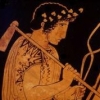


.thumb.png.0d87fc71cb8a644c5d862ceabac1e0d5.png)




